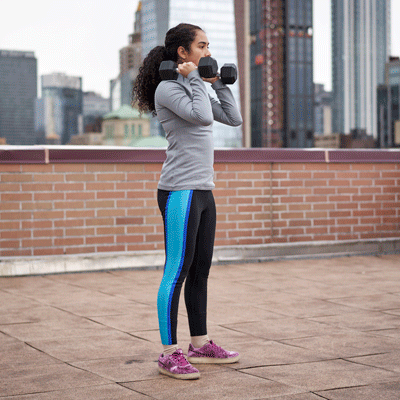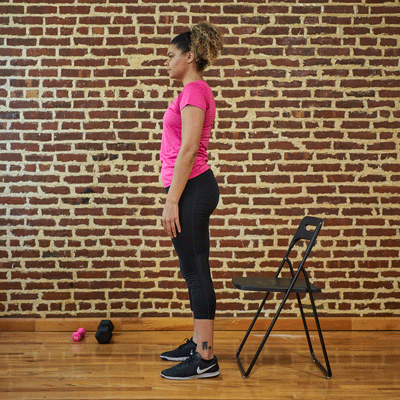The humble squat might just be the most effective exercise you can do: It engages the entire lower half of your body, including your hips, glutes, quads, hamstrings, and calves, while also hitting your core, shoulders, and back.
A perfect squat is a symphony of muscular coordination throughout your entire body, achieving the rare feat of simultaneously building muscle and burning fat thanks to its high metabolic demand. (Read: It burns a lotta calories because it works a lotta muscles.)
But how low should you go? Here’s the lowdown on deep squatting, whether it’s right for you, and how you can do it safely and effectively. Let’s get low.
The benefits of deep squats
There are three common squat depths:
- Full squat: (aka deep squat). Your hips go down below your knees.
- Parallel squat. Your thighs are parallel to the floor.
- Half squat. Your hips remain above your knees during the squat.
Squats are generally great for working out your booty and legs. And deep squats come with benefits like greater muscle activation and athletic performance.
The most effective squat for maximum benefit is a deep squat, with your hip crease going all the way past your knees (or “ass to grass,” as some eloquently put it).
Not only is deep squatting effective, it’s also a one-way ticket to a nice strong booty and strong back.
A 2018 study found that back squats (squats with additional weight or resistance in the upper body) activate the muscles that support your back even more than planks.
Here are the muscles targeted while deep squatting:
- rectus abdominis, obliques, transverse abdominis, and erector spinae (core and abdominal muscles)
- gluteus maximus, minimus, and medius (your rear end)
- hamstrings (the backs of your thighs)
- quadriceps (the fronts of your thighs)
- adductor (groin)
- hip flexors
- calves and legs
A major bonus? You can do squats anywhere: at the gym, outdoors, or in your living room while watching reality TV.
But aren’t deep squats bad for you?
There has been some controversy in conditioning circles about whether deep squats can cause joint damage in the knees or hips. Experts previously recommended keeping your knees from moving past your toes to prevent injury. But more recent studies haven’t confirmed these early hypotheses.
This seems especially true when the program uses a gradual shift into deeper squats. According to a 2013 study, a gradual increase from a parallel squat (where your knees are parallel to the floor) into deeper squats, especially when adding in any weights, is effective and safe as long as you don’t have any existing joint issues.
But it’s also important to warm up and stretch. Without a strong core, loose shoulders, and an engaged back, your risk of injury multiplies.
As long as you don’t have a history of injuries or chronic conditions, “ass to grass” seems like a solid way to go. But if you do have knee, back, or hip issues, there’s nothing wrong with sticking to a modified squat or skipping squats entirely.
Doing what works for you
Modifying exercises according to your needs, stamina, and ability is always the right choice. And always check in with a doctor or physical therapist to make sure everything you’re doing is aligned with your health goals.
So, how do I start doing deep squats?
With care. A deep squat, and any squat for that matter, can be risky when your form is off. You have to pay special attention to mobility, flexibility, stability, and coordination. Yes, sometimes that stuff isn’t very fun, but (and we can’t stress this enough) injuries are a lot less fun.
If you never squat deeply, it’s likely you don’t have enough control, mobility, or strength to do so with weights — yet. Take a step back (literally), remove the weights, and study the basics first.

GIF by Dima Bazak
1. Go at your own pace
When you try squatting, go as low as you comfortably can without pain. Pay attention to your knees, back, and hips and stop if you feel discomfort.
You can always work up to squatting more deeply if that’s your goal.
2. Watch your posture
It’s easy to get into a habit of rounding your shoulders when you attempt squats. Try to keep your spine straight and your head facing forward without straining your neck.
3. Concentrate on mobility
“Mobility” is a word that gets thrown around a lot, but what does it mean in the context of lifting weights? Physical therapist Dr. Mike Reinold defines it as the body’s ability to perform a task without compensation.
Ever tried a biceps curl with a weight that’s a little too heavy and found your hips and back bending and swinging? That’s your body compensating for a lack of strength, bless its heart.
But when form goes down the drain in an attempt to lift a lot of weight, your body is at greater risk for injury. That’s especially true when it comes to squats.
A huge range of issues might contribute to poor mobility, but Reinold emphasizes the importance of flexible ankles, hip flexors, and knees.
“Try lying on your back, bending your legs, and going through a squatting motion. If there’s tightness in a muscle group that keeps the movement from being executed perfectly, that can often be fixed with the right stretches, massage, or a self-myofascial release technique like foam rolling or using a trigger point ball.”
Reinold emphasizes the importance of regularly employing these techniques: A few minutes per day is better than an hour once a week.
4. Engage your muscles
After a full body warmup that includes dynamic stretches, it’s important to remember to engage your muscles as you’re performing the squat. The heavier the weight, the more important it is that your abs, shoulders, and upper back stay engaged, creating a stable base for the weight.
Flex your quads, squeeze your butt, tense your stomach, and, in the case of back squats, activate your upper back by pulling down on the bar. This helps stabilize your body and makes sure all the right muscles are doing their part to keep you from compensating.

GIF by Dima Bazak
5. Go back to basics
There are, sadly, a lot of ways to squat badly. Even if your parallel squats can lift a lot of weight, Reinold recommends beginning your deep squatting routine using only your body weight and then gradually increasing the load.
Starting from the beginning again, while pretty frustrating for advanced lifters, is the best way to fill any lingering gaps in your strength, stability, and form. He also recommends checking in with a physical therapist when embarking on a new weight training regimen.
“You don’t need to have an injury to see a PT,” he says. “If you’re interested in really increasing your strength in a safe way, and especially if you’re having difficulty making progress, find a physical therapist with a good background in movement quality. They’ll look at your body through a different lens and properly assess the best way to move forward.”
Takeaway
There’s no one-size-fits-all approach to strength training, and for some of us, deep squats aren’t on the table. Nevertheless, they’re worth aiming for.
Deep squats are an incredibly effective tool to build strength and lose body fat. The steps we’ve outlined are holistic — better mobility, posture, strength, and flexibility will benefit every aspect of your fitness program.
If you’re feeling the need to get low, give it a go.


0 Commentaires